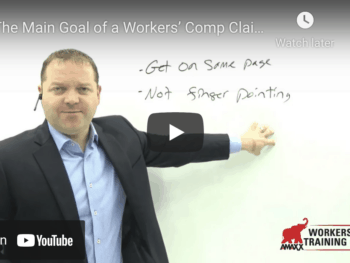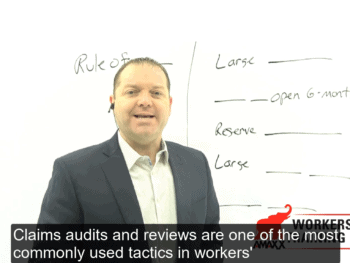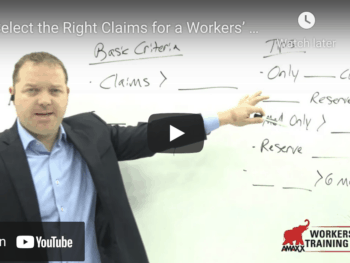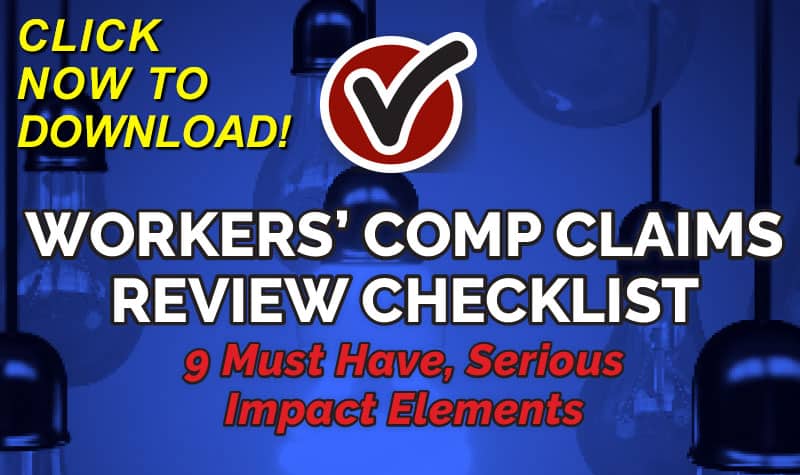
Who is Involved in a File Review?
The file review should include the interested stakeholders in defense of the workers’ compensation claim. There is no limit to attendees, but invitations should include the people who can impact it.
Click Link to Access Free PDF Download
“Workers’ Comp Claims Review Checklist: 9 Must-Have, Serious-Impact Elements”
- Claim Team: It is necessary to have the claim handler involved in the review. Other interested parties can include a claim manager. It can also be a great learning experience for younger claim team members to observe.
- Defense Attorney: The attorney primarily responsible for the defense of a claim must be present. This person can offer input on legal strategy and information concerning the assigned compensation judge, insight on opposing counsel, and background information on the employee.
- Medical Officer: The chief medical officer of the insurance carrier should also be involved in the review. This person can provide information concerning applicable treatment modalities, assessment on the injury (mechanism of injury, nature, and extent, etc.), whether the medical care in the past has been reasonable, and what care the employee may need in the future.
- Employer Representative: It is essential to involve an employer representative at these meetings. This person should have the ability to implement return to work and provide detailed information on the ability of the employee to work in a modified capacity. This person must have the ability to influence people and make a change.
A file review should be non-confrontational and are not designed to place blame.
What is the Purpose of a File Review?
A file review is designed to review cases, examine trends, and implement a course to drive a specific claim toward settlement. There is no specific frequency to have such reviews. Reviews should involve claims determined beforehand so all participants can come to the meeting prepared. It is preferable to have these meetings in person.
When Do You Need a File Review?
A file review should occur with some frequency that encourages all interested stakeholders to think about claims and drive them toward settlement. They can also take place on an ad hoc basis. Indicators that a file review may be necessary can include:
- A stakeholder is not comfortable with the way a claim is going or being handled by the attorney or claim handler;
- There are areas of concern regarding whether claims are being handled per handling instructions;
- Trend lines indicate claims exceed industry averages; or
- There are concerns regarding file management, missing subrogation opportunities, or improper reserves.
These are some instances where it may be the right time to hold a file review.
Where Should a File Review Take Place?
File reviews are best held in person. This should also be a physical location that is convenient to everyone. Having this occur at the employer’s workplace is an excellent idea as it allows all interested stakeholders to observe the firm environment and culture. Things that should be covered during a file review include:
- The name of the employee and their title/job duties;
- Injury information – date, body parts/conditions involved, and nature of medical care;
- Discussion on return to work efforts and information on missed time from work;
- Status of the employee’s medical care and plan proposed by the treating doctor; and
- Anticipation of future medical care.
How to Conduct a File Review?
There is no right way to conduct a file review. Essential items to keep into consideration include:
- Avoid Blame: A file review is a great chance to bring the entire “team” together and improve processes. The “blame game” only drives people apart. Seek to create an environment of trust and confidence.
- Teamwork: The review is an opportunity for people to understand each other better and work as a team. Spend time listening carefully to what others have to say.
- Opportunities to add value: All interested stakeholders should come to the file review with thoughts on how they can add value to resolving the claim. This requires everyone to think outside the box.
Why are File Reviews Necessary?
The value of file reviews should be self-evident. It presents a chance to all interested stakeholders to get together and drive claims toward settlement.
Conclusions
Now is the time to conduct effective file reviews within your workers’ compensation program. A file review is an opportunity for all interested stakeholders on the defense side of the claim to meet in person, improve their skill sets, and develop creative solutions to resolve claims. It also allows for developing relationships that are key in running an effective program.
 Author Michael Stack, CEO Amaxx LLC. He is an expert in workers’ compensation cost containment systems and helps employers reduce their workers’ comp costs by 20% to 50%. He works as a consultant to large and mid-market clients, is a co-author of Your Ultimate Guide To Mastering Workers Comp Costs, a comprehensive step-by-step manual of cost containment strategies based on hands-on field experience, and is the founder & lead trainer of Amaxx Workers’ Comp Training Center, which offers the Certified Master of Workers’ Compensation national designation.
Author Michael Stack, CEO Amaxx LLC. He is an expert in workers’ compensation cost containment systems and helps employers reduce their workers’ comp costs by 20% to 50%. He works as a consultant to large and mid-market clients, is a co-author of Your Ultimate Guide To Mastering Workers Comp Costs, a comprehensive step-by-step manual of cost containment strategies based on hands-on field experience, and is the founder & lead trainer of Amaxx Workers’ Comp Training Center, which offers the Certified Master of Workers’ Compensation national designation.
Contact: mstack@reduceyourworkerscomp.com.
Workers’ Comp Roundup Blog: http://blog.reduceyourworkerscomp.com/
©2022 Amaxx LLC. All rights reserved under International Copyright Law.
Do not use this information without independent verification. All state laws vary. You should consult with your insurance broker, attorney, or qualified professional.

















